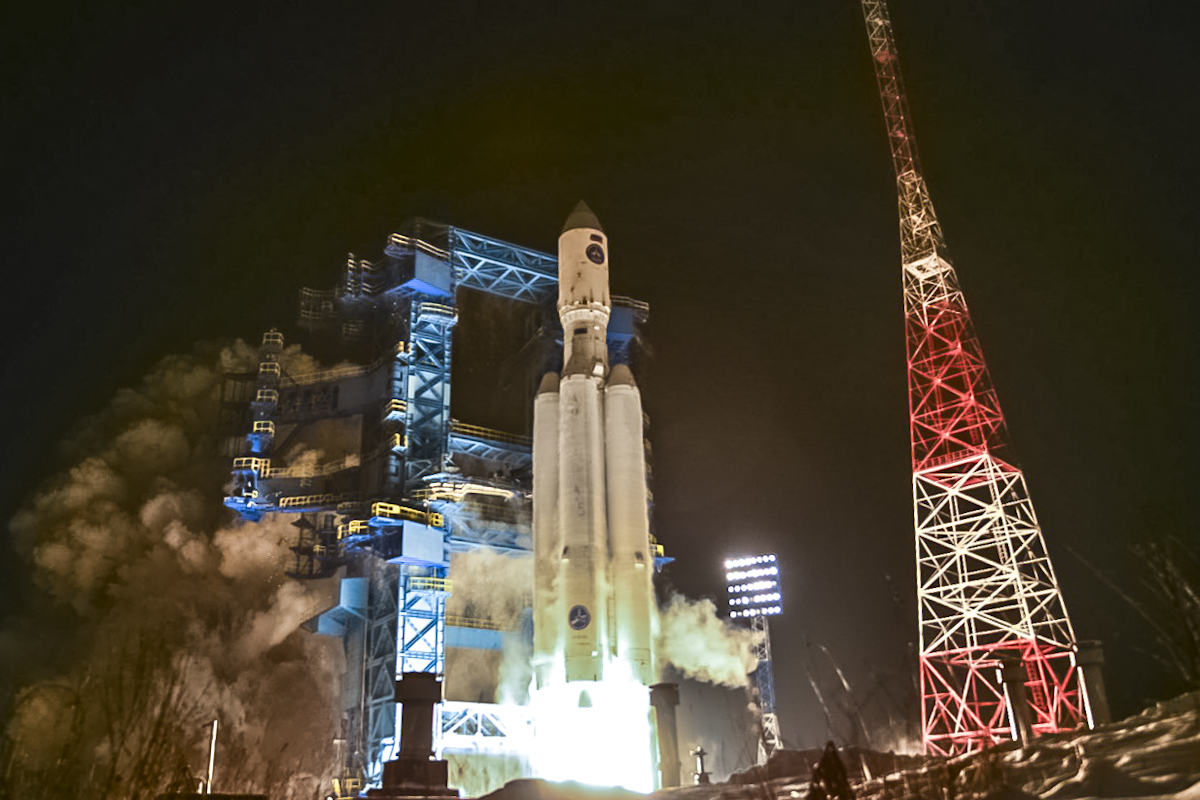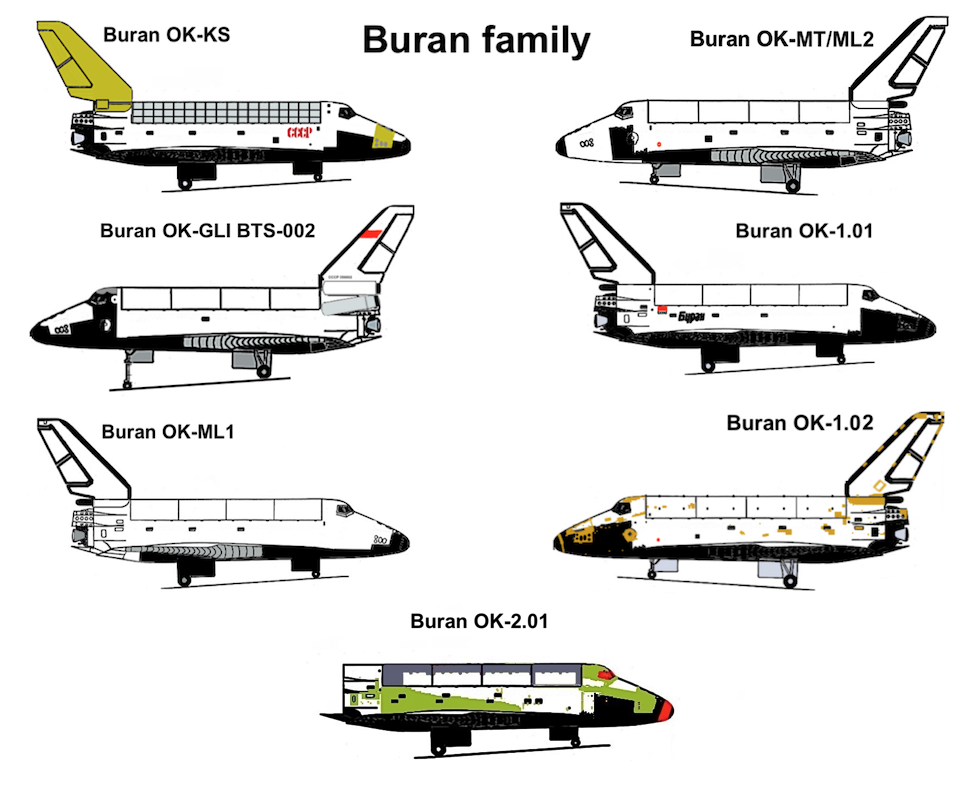|
Baikal (rocket Booster)
The Baikal booster (russian: Байкал) was a proposed reusable flyback booster for the Angara rocket family based on the Angara Universal Rocket Module in 2001. It was designed by the Molniya Research and Industrial Corporation (NPO Molniya) for the Khrunichev Space centre, reusing the flyback and control system for the reusable Buran orbiter. Description The booster would be equipped with an RD-191 rocket engine burning kerosene and liquid oxygen to provide approximately 200 tons of thrust. In addition, it would be equipped with a folding wing stored parallel to the fuselage of the vehicle during the booster stage of the flight. After separation from the Angara launcher's second stage at an altitude of about 75 kilometers and a speed of , the Baikal's wing would rotate 90 degrees and the booster glides in upside down position reducing speed. Once the booster reaches subsonic speeds, a U-turn is performed and an air-breathing RD-33 jet engine in its nose section is star ... [...More Info...] [...Related Items...] OR: [Wikipedia] [Google] [Baidu] |
Baikal2
Lake Baikal (, russian: Oзеро Байкал, Ozero Baykal ); mn, Байгал нуур, Baigal nuur) is a rift lake in Russia. It is situated in southern Siberia, between the Federal subjects of Russia, federal subjects of Irkutsk Oblast, Irkutsk Oblasts of Russia, Oblast to the northwest and the Republic of Buryatia to the southeast. With of water, Lake Baikal is the world's List of lakes by volume, largest freshwater lake by volume, containing 22–23% of the world's fresh surface water, more than all of the North American Great Lakes combined. It is also the world's List of lakes by depth, deepest lake, with a maximum depth of , and the world's ancient lake, oldest lake, at 25–30 million years. At —slightly larger than Belgium—Lake Baikal is the world's List of lakes by area, seventh-largest lake by surface area. It is among the world's clearest lakes. Lake Baikal is home to thousands of species of Plant, plants and animals, many of them endemic to the region. ... [...More Info...] [...Related Items...] OR: [Wikipedia] [Google] [Baidu] |
Booster (rocketry)
A booster rocket (or engine) is either the first stage of a multistage launch vehicle, or else a shorter-burning rocket used in parallel with longer-burning sustainer rockets to augment the space vehicle's takeoff thrust and payload capability. Boosters are traditionally necessary to launch spacecraft into low Earth orbit (absent a single-stage-to-orbit design), and are especially important for a space vehicle to go beyond Earth orbit. The booster is dropped to fall back to Earth once its fuel is expended, a point known as ''booster engine cut-off'' (BECO). Following booster separation, the rest of the launch vehicle continues flight with its core or upper-stage engines. The booster may be recovered, refurbished and reused, as was the case of the steel casings used for the Space Shuttle Solid Rocket Boosters. Drop-away engines The SM-65 Atlas rocket used three engines, one of which was fixed to the fuel tank, and two of which were mounted on a skirt which dropped away at BECO ... [...More Info...] [...Related Items...] OR: [Wikipedia] [Google] [Baidu] |
Angara (rocket Family)
The Angara rocket family (Russian: Ангара) is a family of launch vehicles being developed by the Moscow-based Khrunichev State Research and Production Space Center. The launch vehicles are to put between and into low Earth orbit and are intended, along with Soyuz-2 variants, to replace several existing launch vehicles. History After the dissolution of the Soviet Union, many formerly Soviet launch vehicles were built in or required components from companies now located in Ukraine, such as Yuzhnoye Design Bureau, which produced Zenit-2, and Yuzhmash, which produced Dnepr and Tsyklon. Additionally, the Soviet Union's main spaceport, Baikonur Cosmodrome, was located in Kazakhstan, and Russia encountered difficulties negotiating for its use. This led to the decision in 1992 to develop a new entirely Russian launch vehicle, named Angara, to replace the launch vehicles now built outside of the country, and ensure Russian access to space without Baikonur. It was decided that ... [...More Info...] [...Related Items...] OR: [Wikipedia] [Google] [Baidu] |
Universal Rocket Module
Universal Rocket Module (URM) is the name of the modular liquid fuelled first and second stage of the Angara expendable launch system. The first stage and booster variant is referred to as URM-1, while the second stage is referred to as URM-2. The URM-2 is derived from the Soyuz-2 Block I second stage. URM-1 is a unitary structure 2.9 meters in diameter and 25 meters in length that includes an oxidizer tank, a fuel tank (both tanks being coupled by a spacer) and an RD-191 engine burning RP-1 fuel with liquid oxygen producing a thrust of 1.92 MN. URM-1 was first flown in 2014 on the Angara 1.2PP suborbital test flight. Angara can fly with either one URM-1 in the case of Angara 1.2 and Angara 1.2PP, or one URM-1 as a sustainer core with four additional URM-1s as boosters for Angara A5. URM-2 is a modified Block I stage, 3.6 meters in diameter and 6.9 meters in length. It is powered by a single RD-0124A producing 294 kilonewtons, derived from Block I's RD-0124. URM-2 was fir ... [...More Info...] [...Related Items...] OR: [Wikipedia] [Google] [Baidu] |
NPO Molniya
NPO Molniya (''lightning'') (russian: Научно-производственное объединение «Молния») is a Russian scientific and production enterprise, founded on February 26, 1976. Currently part of Rostec. Space systems At present, NPO Molniya is working on reusable launch systems for space applications. Aircraft The NPO Molniya Molniya-1 is a three surface design with single pusher propeller and twin tail booms. In the late 1990s, the company proposed a number of larger types based on the three surface configuration. *Molniya 400 - a proposed jet cargo aircraft or airliner with a high-mounted wing and powered by two PS-90A turbofans. Freighter version would have had a rear fuselage ramp. * Molniya-1000 Heracles - a proposed super heavy freighter to replace the VM-T Atlant and An-225 as a space load carrier. Unusual twin open fuselage design with the shuttle or other payload carried between the fuselages. A high mounted wing with six turbofan engine ... [...More Info...] [...Related Items...] OR: [Wikipedia] [Google] [Baidu] |
Khrunichev
The Khrunichev State Research and Production Space Center (''Государственный космический научно-производственный центр (ГКНПЦ) имени М. В. Хру́ничева'' in Russian) is a Moscow-based manufacturer of spacecraft and space-launch systems, including the Proton and Rokot rockets, and the Russian modules of Mir and the International Space Station. The company's history dates back to 1916, when an automobile factory was established at Fili, western suburb of Moscow. It soon switched production to airplanes and during World War II produced Ilyushin Il-4 and Tupolev Tu-2 bombers. A design bureau, OKB-23, was added to the company in 1951. In 1959, the company started developing intercontinental ballistic missiles, and later spacecraft and space launch vehicles. The company designed and produced all Soviet space stations, including Mir. OKB-23, renamed to ''Salyut Design Bureau'', became an independent company in ... [...More Info...] [...Related Items...] OR: [Wikipedia] [Google] [Baidu] |
Buran (spacecraft)
''Buran'' (russian: Буран, , meaning "Snowstorm" or "Blizzard"; GRAU index serial number: 11F35 1K, construction number: 1.01) was the first spaceplane to be produced as part of the Soviet/Russian Buran program. Besides describing the first operational Soviet/Russian shuttle orbiter, "Buran" was also the designation for the entire Soviet/Russian spaceplane project and its orbiters, which were known as "Buran-class orbiters". Buran completed one uncrewed spaceflight in 1988, and was destroyed in the 2002 collapse of its storage hangar. The Buran-class orbiters used the expendable Energia rocket, a class of super heavy-lift launch vehicle. It is named after the Asian wind. Construction The construction of the Buran spacecraft began in 1980, and by 1984 the first full-scale orbiter was rolled out. Over 1000 companies all over the Soviet Union were involved in construction and development. The Buran spacecraft was made to be launched on the Soviet Union's super-heavy ... [...More Info...] [...Related Items...] OR: [Wikipedia] [Google] [Baidu] |
RD-33
The Klimov RD-33 is a turbofan jet engine for a lightweight fighter jet that is the primary engine for the Mikoyan MiG-29 and CAC/PAC JF-17 Thunder. It was developed in OKB-117 led by S. P. Izotov (now OAO Klimov) from 1968 with production starting in 1981. Previous generations of Russian supersonic fighters such as the MiG-21 and MiG-23 used turbojets, but western fighters such as the F-111 and F-4K introduced the use of afterburning turbofans in the 1960s which were more efficient. The RD-33 was the first afterburning turbofan engine produced by the Klimov company of Russia in the thrust class. It features a modular twin-shaft design with individual parts that can be replaced separately. Variants In early 1970s the RD-33 was selected for new light fighter jet, later becoming Mikoyan MiG-29, the other option was Tumansky R-67-300. Years of development has built an extensive engine family. A newly designed thrust vectoring nozzle (TVN) is now available. New models of the RD-33 ... [...More Info...] [...Related Items...] OR: [Wikipedia] [Google] [Baidu] |
Plesetsk Cosmodrome
Plesetsk Cosmodrome ( rus, Космодром «Плесецк», r=Kosmodrom "Plesetsk", p=kəsmɐˈdrom plʲɪˈsʲet͡sk) is a Russian spaceport located in Mirny, Arkhangelsk Oblast, about 800 km north of Moscow and approximately 200 km south of Arkhangelsk, the cosmodrome dates to 1957. Originally developed as an ICBM site for the R-7 missile, it also served for numerous satellite launches using the R-7 and other rockets. Its high latitude makes it useful only for certain types of launches, especially the Molniya orbits, so for much of the site's history it functioned as a secondary location, with most orbital launches taking place from Baikonur, in the Kazakh SSR. With the end of the Soviet Union, Baikonur became a foreign territory, and Kazakhstan charged $115 million usage fees annually. Consequently, Plesetsk has seen considerably more activity since the 2000s. Overview Plesetsk () is used especially for military satellites placed into high inclination an ... [...More Info...] [...Related Items...] OR: [Wikipedia] [Google] [Baidu] |
Paris Air Show
The Paris Air Show (french: Salon international de l'aéronautique et de l'espace de Paris-Le Bourget, Salon du Bourget) is a trade fair and air show held in odd years at Paris–Le Bourget Airport in north Paris, France. Organized by the French aerospace industry's primary representative body, the ''Groupement des industries françaises aéronautiques et spatiales'' (GIFAS), it is the largest air show and aerospace-industry exhibition event in the world, measured by number of exhibitors and size of exhibit space, followed by UK's Farnborough Air Show, Dubai Air Show, and Singapore Airshow. First held in 1909, the Paris Air Show was held every odd year from 1949 to 2019, when the 53rd Air Show attracted 2,453 exhibitors from 49 countries and occupied more than 125,000 square meters. Organizers canceled the 2021 show due to the COVID pandemic and said it would resume in 2023. It is a large trade fair, demonstrating military and civilian aircraft, and is attended by many military ... [...More Info...] [...Related Items...] OR: [Wikipedia] [Google] [Baidu] |
TsAGI
The Central Aerohydrodynamic Institute (also (Zhukovsky) Central Institute of Aerodynamics, russian: Центра́льный аэрогидродинами́ческий институ́т, ЦАГИ, Tsentral'nyy Aerogidrodinamicheskiy Institut, TsAGI) was founded in Moscow by Russian aviation pioneer Nikolai Yegorovich Zhukovsky on December 1, 1918. History From 1925 and up to the 1930s, TsAGI developed and hosted Tupolev's AGOS (''Aviatziya, Gidroaviatziya i Opytnoye Stroitelstvo'', the "Aviation, Hydroaviation, and Experimental Construction"), the first aircraft design bureau in Soviet Union, and at the time the main one. In 1930, two other major aircraft design bureaus in the country were the Ilyushin's TsKB (''Tsentralnoye Konstruksionnoye Byuro'' means "Central Design Bureau") and an independent, short-lived Kalinin's team in Kharkiv. In 1935 TsAGI was partly relocated to the former dacha settlement ''Otdykh'' (literally, "Relaxation") converted to the new urban-type set ... [...More Info...] [...Related Items...] OR: [Wikipedia] [Google] [Baidu] |




.jpg)


.png)

